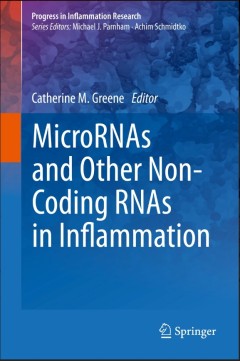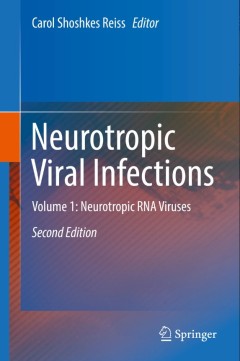Filter by

Multiple Sclerosis, Mad Cow Disease and Acinetobacter
The aim of this book is to publicise and bring to a wider audience the concept that the cause of two neurological diseases, namely multiple sclerosis (MS) and “mad cow disease” also known as “bovine spongiform encephalopathy” are related through exposure to a common microbe Acinetobacter which is found in human sinuses, on skin and in the soil. An infection is the cause of a neurologica…
- Edition
- 1
- ISBN/ISSN
- 978-3-319-02734-0
- Collation
- XVIII, 200
- Series Title
- -
- Call Number
- -

MicroRNAs and Other Non-Coding RNAs in Inflammation
The book serves as a comprehensive resource for scientists and clinicians studying the role of non-coding RNAs in inflammation (viral infections, wound inflammation), human inflammatory diseases (i.e. rheumatoid arthritis, Crohn’s disease, diabetes) and innate immunity. It provides a universal reference work comprising both basic and specialized information. Given that ncRNAs represent new th…
- Edition
- 1
- ISBN/ISSN
- 978-3-319-13689-9
- Collation
- X
- Series Title
- Progress in Inflammation Research
- Call Number
- -

MicroRNAs and Other Non-Coding RNAs in Inflammation
The book serves as a comprehensive resource for scientists and clinicians studying the role of non-coding RNAs in inflammation (viral infections, wound inflammation), human inflammatory diseases (i.e. rheumatoid arthritis, Crohn’s disease, diabetes) and innate immunity. It provides a universal reference work comprising both basic and specialized information. Given that ncRNAs represent new th…
- Edition
- 1
- ISBN/ISSN
- 978-3-319-13688-2
- Collation
- X, 237
- Series Title
- Progress in Inflammation Research
- Call Number
- -

Effect of spaceflight and spaceflight analogue culture on human and microbial…
Many breakthroughs in biological research and translational healthcare advancements have been achieved by studying the response of biological systems to extreme environments. The spaceflight platform provides a unique environment where researchers can explore fundamental questions into cellular and molecular response mechanisms to unveil novel insight into human health and disease. Since the ph…
- Edition
- -
- ISBN/ISSN
- 9781493932764
- Collation
- xviii, 301 pages : illustrations
- Series Title
- -
- Call Number
- 616.0791

Epstein Barr Virus Volume 2 One Herpes Virus: Many Diseases
Epstein Barr virus (EBV) was discovered as the first human tumor virus around 50 years ago. Since its discovery in Burkitt’s lymphoma it has been associated with various other malignancies, infectious mononucleosis and even autoimmune diseases. The two book volumes on EBV summarize the first 50 years of research on this tumor virus, starting with historical perspectives on discovery, oncogeni…
- Edition
- -
- ISBN/ISSN
- 978-3-319-22834-1
- Collation
- VI, 505
- Series Title
- -
- Call Number
- -

Environmental Influences on the Immune System
This book brings together articles on the overarching theme of how the environment shapes the immune system. The immune system is commonly assumed to respond to harmful pathogens such as bacteria and viruses. However, harmless bacteria, chemicals, stress, normal food and other factors can also trigger, shape or interfere with the immune system, often producing adverse effects. Yet, it is als…
- Edition
- -
- ISBN/ISSN
- 978-3-7091-1890-0
- Collation
- 17 b/w illustrations, 7 illustrations in colour
- Series Title
- -
- Call Number
- -

Endogenous ADP-Ribosylation
This volume gathers the latest exciting findings on ADP-ribosylation from renowned experts in the field. It includes ten chapters, organized into the following three thematic sections: · Evolution and detection of endogenous ADP-ribosylation · ADP-ribosylation by the ARTC family of ADP-ribosyltransferases (R-S-E ARTs) · ADP-ribosylation by the ARTD family of ADP-ribosyltransfe…
- Edition
- -
- ISBN/ISSN
- 978-3-319-10771-4
- Collation
- VIII, 213
- Series Title
- -
- Call Number
- -

Endocannabinoids
There is currently considerable interest in the development of medicines that would enhance endocannabinoid-induced “autoprotection”, for example through inhibition of endocannabinoid metabolizing enzymes or cellular uptake processes or that would oppose endocannabinoid-induced “autoimpairment”. This volume describes the physiology, pathophysiology and pharmacology of the endocannabinoi…
- Edition
- -
- ISBN/ISSN
- 978-3-319-20825-1
- Collation
- XII, 475
- Series Title
- -
- Call Number
- -

Neurotropic Viral Infections:Volume 2: Neurotropic Retroviruses, DNA Viruses,…
This second edition is a comprehensive study of the viruses that affect the brain and the central nervous system. Along with a focus on the viruses themselves, it addresses the diseases they cause, current treatments and preventive measures. Also discussed are the unique aspects of how viruses cause disease and why certain hosts are more susceptible (e.g., polymorphisms, age, co-morbidities). …
- Edition
- 2
- ISBN/ISSN
- 978-3-319-33188-1
- Collation
- XII, 557
- Series Title
- -
- Call Number
- -

Neurotropic Viral Infections:Volume 1: Neurotropic RNA Viruses
This second edition is a comprehensive study of the viruses that affect the brain and the central nervous system. Along with a focus on the viruses themselves, it addresses the diseases they cause, current treatments and preventive measures. Also discussed are the unique aspects of how viruses cause disease and why certain hosts are more susceptible (e.g., polymorphisms, age, co-morbidities). …
- Edition
- 2
- ISBN/ISSN
- 978-3-319-33131-7
- Collation
- X, 370
- Series Title
- -
- Call Number
- -
 Computer Science, Information & General Works
Computer Science, Information & General Works  Philosophy & Psychology
Philosophy & Psychology  Religion
Religion  Social Sciences
Social Sciences  Language
Language  Pure Science
Pure Science  Applied Sciences
Applied Sciences  Art & Recreation
Art & Recreation  Literature
Literature  History & Geography
History & Geography